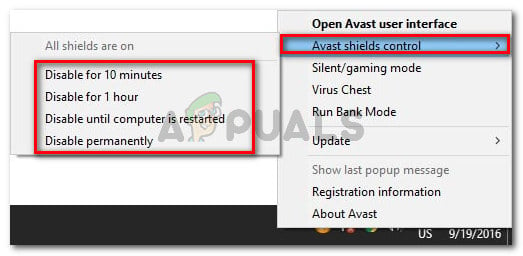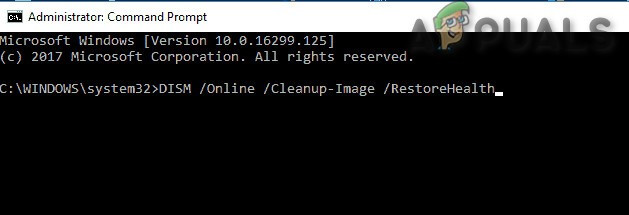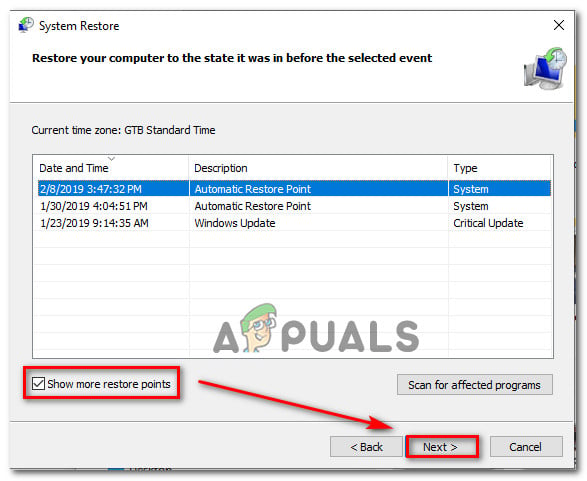Exception Processing Message 0xc000007b Parameters on Startup Fix
The ‘Exception Processing Message 0xc000007b Parameters‘ error appears at every system startup (after reboots or regular startups). In most cases, this error appears as part of a series of startup errors related to system .DLLs and .exe files.

What’s causing the ‘Exception Processing Message 0xc000007b Parameters’ error?
- Invalid File path – One potential culprit that might trigger this problem is a series of files that are no longer located on the usual path. This scenario can be fixed by repairing the system files, but in case you don’t want to go through with that, you can hide the startup errors for good if you deem them harmless to your system.
- 3rd party AV interference – As it turns out, there are a couple of 3rd parties AV/firewall suites that might cause this problem after ending up quarantining some healthy system files due to a false positive. In this case, you can fix the issue by uninstalling the overprotective suite and running a Windows utility capable of dealing with file corruption.
- System File Corruption – Corrupted Windows files can ultimately lead to startup errors associated with this error code. These things typically appear after a botched update, an unexpected machine shutdown or a virus infection. If this scenario is applicable, you can get the issue resolved by fixing the corrupted instances with a couple of built-in utilities (DISM and SFC), by using system restore or by refreshing every Windows component with a procedure like clean install or repair install.
Method 1: Masking the startup errors
If the ‘Exception Processing Message 0xc000007b Parameters‘ error doesn’t produce any other symptoms than a few startup errors, you should also consider the possibility of masking the issue. This is not recommended since you will no longer be notified of other errors in the future, but it will save you from a huge pain in the back if you have a ton of apps/user profiles on your current OS installation.
As several affected users have reported, you can ensure that the ‘Exception Processing Message 0xc000007b Parameters‘ error goes away for good by accessing your Registry Editor and changing the value of Error Mode to from 0 to 2.
This will ensure that no startup errors will be displayed ever again.
Here’s a quick guide on how to do this:
- Press Windows key + R to open up a Run dialogue box. Next, type ‘regedit’ in the text box and press Enter to open up the Registry Editor. When you’re prompted by the UAC (User Account Control) prompt, click Yes to grant administrative privileges.
- Once you’re inside Registry Editor, use the left-hand section to navigate to the following location:
Computer\HKEY_LOCAL_MACHINE\SYSTEM\ControlSet001\Control\Windows
Note: You can also get there instantly by pasting the location directly into the navigation bar at the top and pressing Enter.
- After you manage to get to the correct location, move over to the right-hand pane and double-click on Error Mode.
- Inside the newly opened Edit DWORD (32-bit) Value window, set the Base to Hexadecimal and the Value data to 0.
- Next, hit Ok to save the changes, then close the Registry Editor utility and restart your computer.
- At the next startup, you will no longer see any startup errors.

Hiding the error using Registry Editor
In case you are looking for a fix for this issue rather than a way to hide the error, move down to the next method below.
Method 2: Uninstall 3rd party interference (if applicable)
As it turns out, this issue might also occur due to some kind of 3rd party interference. As several different affected users have reported, this issue might also occur due to an overprotective AV/firewall suite that recently quarantined some system file items due to a false positive.
In this case, you might encounter startup errors with the ‘Exception Processing Message 0xc000007b Parameters‘ error or even see your computer getting stuck in a persistent boot loop.
Avast and Comodo are two commonly reported AV suites known for causing this problem. If you’re using a 3rd party tool that you suspect might be responsible for this issue, you should be able to fix it either by disabling the real-time protection or by uninstalling the suite altogether.
If you want to start with the less-intrusive approach, you should start by disabling the real-time protection and doing a restart. Of course, this procedure will be different depending on the 3rd party suite that you’re using, but typically, you can do this directly from the taskbar icon of your antivirus or firewall suite.

If that’s not enough, you might need to uninstall your 3rd party security suite altogether and ensure that you’re not leaving behind any leftover files that might still cause this problem. If you want step by step instructions that will help you do this, use this article (here) to uninstall your 3rd party suite along with any remnant files.
Note: Even if your antivirus was to blame for causing this issue, you will still need one of the utilities below in order to restore the files that got quarantined by this false possible.
But if you followed the instructions below to no avail or this scenario wasn’t applicable, move down to the next potential fix below.
Method 3: Performing DISM and SFC Scans
In most reported cases, this particular ‘Exception Processing Message 0xc000007b Parameters‘ error turned out to be caused by an underlying system corruption. This was reported on Windows 10, Windows 7 and Windows 8.1.
If this scenario is applicable to your particular situation, you should be able to resolve the issue by running a couple of built-in utilities that are capable of dealing with corrupted system files by replacing them with healthy copies.
SFC (System File Checker) and DISM (Deployment Image Servicing and Management) will ultimately help you fix system file corruption, but they do it in different ways.
SFC is much more competent at dealing with logical errors that might cause this behaviour, while DISM is superior at dealing with broken dependencies that might cause system errors. Because of this, we encourage you to run both utilities in order to maximize your chances of resolving your particular instance of system file corruption.
Here’s a quick guide on running both the SFC and DISM scan in order to fix instances of file corruption from an elevated Command Prompt:
- Press Windows key + R to open up a Run dialogue box. Next, inside the dialogue box type ‘cmd” and press Ctrl + Shift + Enter to open up an elevated Command Prompt. When you arrive at the User Account Control (UAC) prompt, click Yes to grant admin access to the CMD window.

Opening a normal Command Prompt window - Once you’re inside the elevated CMD prompt, type the following command and press Enter to kick-start an SFC scan:
sfc /scannow

Running SFC Note: Keep in mind that SFC uses a locally cached copy that will automatically replace corrupted copies with healthy instances. But once you start this utility, it’s important that you don’t interrupt no matter what – doing so will leave your system exposed to logical errors on your HDD that might cause other problems.
- After the operation is complete, restart your computer. At the next startup sequence, follow step 1 again to open up another elevated command prompt.
- Once you manage to return to an elevated CMD window, type the following command and press Enter to initiate a DISM scan:
DISM /Online /Cleanup-Image /RestoreHealth

Run DISM Command Note: Remember that DISM will require a stable Internet connection in order to be able to download healthy copies to replace corrupted instances. It uses official channels (the Windows Update component) to download corruption-free files.
- Once both scans are completed, restart your computer once again and see if the issue is resolved at the next computer startup.
If you’re still encountering the same ‘Exception Processing Message 0xc000007b Parameters‘ error, move down to the next method below.
Method 4: Using System Restore
In case you only noticed that the startup error started to occur recently, it’s likely that a recent system change is causing this behaviour. In most cases, a driver or update installation will end up creating some corrupted registry locations that will trigger this startup error.
If this scenario is applicable in your case, you should be able to fix the error message by running the System Restore utility to restore your machine point to a previous point in time when the same circumstances were not applicable.
But before you get started with this operation, keep in mind that this utility is configured by default to create and store regular restore snapshots before important system changes (like a critical system update installation, a driver update, etc.) So unless you made some specific changes to the System Restore utility or you use some system optimisation tool, you should have plenty of systems restore snapshots to choose from.
However, if you restore your computer state with this utility, every change that was enforced since the restore snapshot was created (app installation, enforced user preference, driver updates, etc.) will be lost.
If you understand how this utility works and you still want to use it to fix the ‘Exception Processing Message 0xc000007b Parameters‘ error, move down to the next method below:
- Open up a Run dialogue box by pressing Windows key + R. Next, type ‘rstrui’ and press Enter to open up the System Restore menu.

Opening the System Restore wizard via Run box - Once you’re at the initial System Restore screen, click on Next to make your way to the next menu.

Using System Restore - At the next screen, start by ensuring that the box associated with Show more restore points is checked. Once you’ve made sure that it is, start comparing the dates of each available system restore point and select one that is dated just before the apparition of your issue.
- With the appropriate system restore point selected, click Next to advance to the final menu.

Restoring your system to a previous point in time - Once you arrive at this final point, this utility should be ready to go. All you need to do now is to initiate a system restore process by clicking the Finish button.
- As soon as you do this, the utility will restart your computer and the older state will be mounted at the next computer startup.
- At the next startup sequence, pay attention to see if you still see the ‘Exception Processing Message 0xc000007b Parameters‘ error.
If the same exact problem is still occurring after every boot, move down to the next method below.
Method 5: Performing a repair / clean install
If none of the utilities presented above has allowed you to pinpoint and fix the issue, it’s pretty clear that your system is suffering from and underlying system corruption problem that cannot be resolved conventionally.
In this case, the most efficient way of getting rid of the ‘Exception Processing Message 0xc000007b Parameters’ error is to follow a procedure that will allow you to refresh every system component. When it comes to achieving this, you really have two ways forward:
- Clean install – This is an easier procedure. It doesn’t require you to own an installation media and it can be triggered with just a few steps. But the major disadvantage is that unless you back up your data in advance, you will lose everything (including your files, games, applications, user preferences and everything else).
- Repair Install – Also known as in-place repair, this is the more tedious approach that will require you to produce an installation media that’s compatible with your operating system version. However, the major advantage is that you will be allowed to keep your media, your applications, your games and everything else.
Feel free to follow whichever guide is closer to what you’re looking to achieve.




